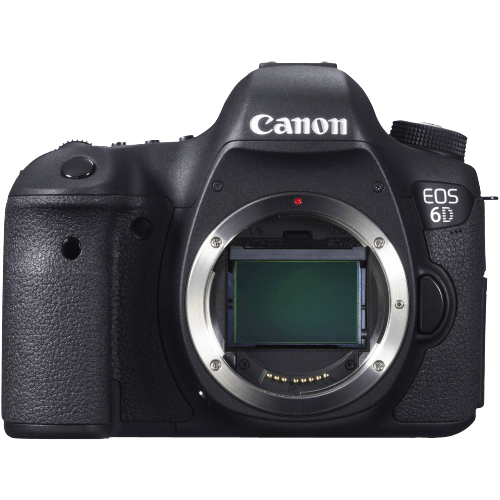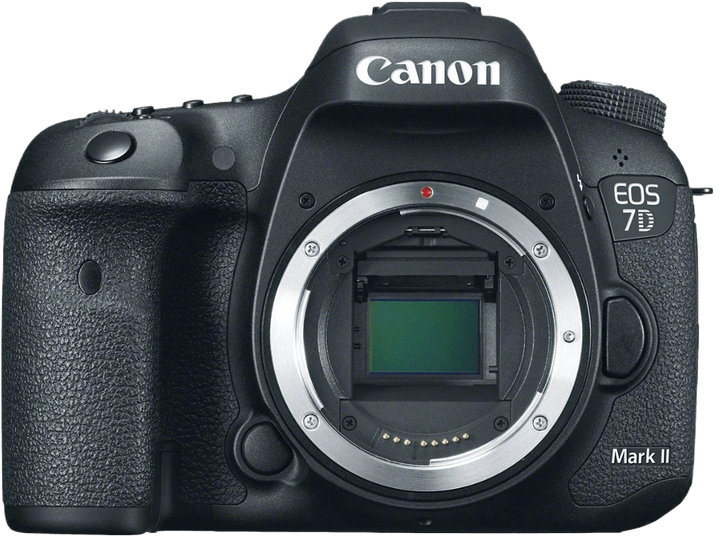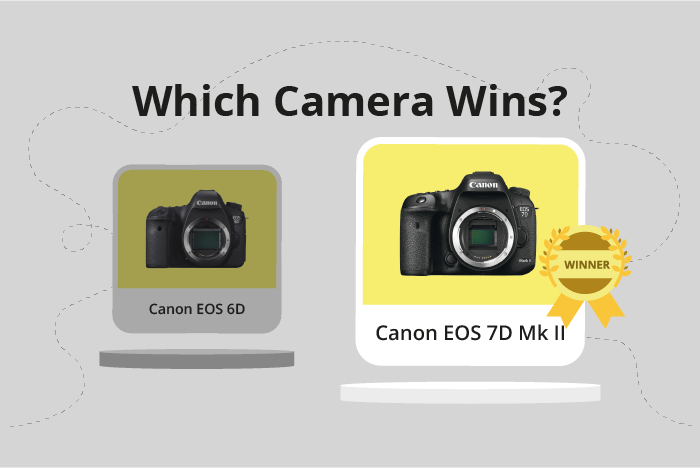Canon EOS 6D vs EOS 7D Mark II Comparison
Canon EOS 6D

Canon EOS 7D Mark II

The Canon EOS 7D Mark II edges out the Canon EOS 6D with a score of 60/100 compared to 59/100. Both cameras are DSLRs, announced in 2012 and 2014 respectively, and share similar dimensions. The 7D Mark II is slightly larger at 149 x 112 x 78mm and heavier at 910g, while the 6D measures 145 x 111 x 71mm and weighs 770g.
The 7D Mark II boasts a lower launch price of $1800, making it more affordable than the 6D, which was introduced at $2099. Despite the marginal difference in scores, the 7D Mark II offers better value for money. The 6D, on the other hand, is lighter, making it a more portable option for photographers on the go.
Taking the specifications into account, the 7D Mark II is the winner in terms of affordability, while the 6D offers portability advantage.
Canon EOS 6D vs EOS 7D Mark II Overview and Optics
The Canon EOS 6D and Canon EOS 7D Mark II both receive an optics score of 61/100. These cameras share several common specifications, such as 20.2 megapixels, CMOS sensor type, no image stabilization, and a shooting speed of 4.5 for the 6D and 10 for the 7D Mark II.
The EOS 6D has a full frame sensor size and a Digic 5+ processor, while the 7D Mark II has an APS-C sensor size and a Dual Digic 6 processor. The 6D’s full frame sensor size contributes to its higher DXOMARK score of 82, compared to the 7D Mark II’s score of 70. This means the 6D’s sensor provides better overall image quality and low-light performance.
On the other hand, the 7D Mark II has a faster shooting speed of 10 frames per second, compared to the 6D’s 4.5 frames per second. This makes the 7D Mark II a better choice for capturing fast-moving subjects or action photography. Additionally, the 7D Mark II’s Dual Digic 6 processor allows for faster image processing and improved performance in certain situations.
Both cameras have their respective advantages, with the 6D excelling in image quality and low-light performance, and the 7D Mark II performing better in fast-action situations. Ultimately, the choice between these two cameras depends on the specific needs and preferences of the photographer.
Canon EOS 6D vs EOS 7D Mark II Video Performance
The Canon EOS 7D Mark II outperforms the Canon EOS 6D in video capabilities with a score of 56/100 compared to the 6D’s score of 43/100. Both cameras share some common video specifications, including Full HD (1920 x 1080) maximum video resolution and the absence of built-in time-lapse functionality.
The 7D Mark II’s superior score is largely due to its higher maximum video frame rate of 60fps, compared to the 6D’s 30fps. This faster frame rate allows for smoother video playback and more flexibility when capturing fast-moving subjects or creating slow-motion effects. The 7D Mark II’s video quality is further enhanced by its advanced autofocus system, which provides more accurate and responsive tracking of subjects in motion.
The 6D, while scoring lower overall, does have some advantages in video capabilities. Its full-frame sensor allows for better low-light performance and shallower depth of field, which can be beneficial for creating a more cinematic look in videos. Additionally, the 6D’s smaller size and lighter weight make it more portable and easier to handle during long video shoots.
Considering these factors, the Canon EOS 7D Mark II is the clear winner in terms of video capabilities, offering a higher frame rate and better autofocus performance. However, the Canon EOS 6D still has its merits, particularly in low-light situations and for those seeking a more compact camera. Ultimately, the best choice will depend on the specific needs and priorities of the user.
Canon EOS 6D vs EOS 7D Mark II Features and Benefits
The Canon EOS 6D and Canon EOS 7D Mark II both have a feature score of 57 out of 100, making it a tie in this comparison. Despite their equal scores, each camera excels in different aspects.
Both cameras share several common specifications. They have a screen size of 3 inches and a screen resolution of 1,040,000 dots. Neither camera has a touchscreen or flip screen. Additionally, both cameras come equipped with GPS and WIFI capabilities but lack Bluetooth connectivity.
The Canon EOS 6D surpasses the 7D Mark II in some aspects. For instance, its full-frame sensor provides better low-light performance and image quality. This advantage makes the 6D a great choice for photographers who prioritize image quality and work in varying lighting conditions.
On the other hand, the Canon EOS 7D Mark II has a faster continuous shooting speed, making it more suitable for action and sports photography. Its advanced autofocus system also provides better subject tracking, ensuring sharp images even when capturing fast-moving subjects.
Considering these differences, it is clear that each camera caters to a specific type of photographer. The Canon EOS 6D is ideal for those who value image quality and low-light performance, while the Canon EOS 7D Mark II is better suited for action and sports photography. Ultimately, the choice between these two cameras depends on the individual’s photography needs and preferences.
Canon EOS 6D vs EOS 7D Mark II Storage and Battery
The Canon EOS 7D Mark II outperforms the Canon EOS 6D in storage and battery with a score of 65/100 compared to the 6D’s 45/100. Both cameras share the same battery type, LP-E6, and neither has USB charging capabilities. Additionally, they both accept SD, SDHC, and SDXC memory cards.
The 7D Mark II surpasses the 6D with its dual memory card slots, allowing for greater storage capacity and flexibility. It also accepts Compact Flash cards, further expanding its storage options. However, the 6D has a longer battery life, providing 1090 shots compared to the 7D Mark II’s 670 shots.
Considering the storage and battery aspects, the 7D Mark II has an advantage in storage options and capacity, while the 6D excels in battery life.
Alternatives to the Canon EOS 6D and EOS 7D Mark II
Are you still undecided about which camera is right for you? Have a look at these popular comparisons that feature the Canon EOS 6D or the Canon EOS 7D Mark II:

